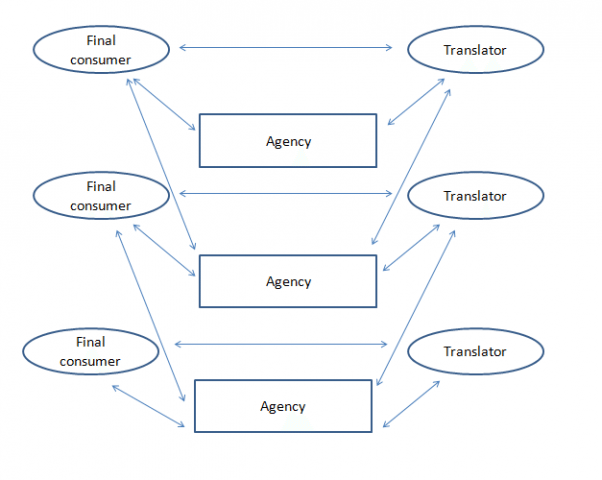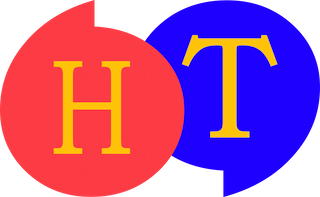Where on Earth Is the Translation Market?
Continuous translation work is crucial to becoming a translator. This means seeking out and meeting clients. After that, you must form a contract with your clients, do the work, send your work to your clients, make and send an invoice, and then receive payment. The abstract (or physical) place where all those things take place is a “market.” So where do you think the translation market is?
This may sound strange to you and you might be wondering, “Is there even such a thing?”
Maybe some of you are imaging a place like a publishing company. Or perhaps you’re thinking about some kind of shabby 2nd floor office with a sign saying something like “Translation/notarization” that you may sometimes see while walking down the streets of Jongno, Seoul. If so, you should clear your head of those kinds of outdated images.
Since the 1990’s, the world has fundamentally changed. This is all thanks to the Internet. Although you might not be able to see it yet, the Internet is changing the way people live, work, play, and even think. I won’t drone on with more details about that. The clear and concise answer to today’s title question is as follows:
Today, the translation market is on the Internet.
[bctt tweet=”Today, the translation market is on the Internet.” username=””]
Although this is currently an all-too-obvious fact for me and many others, I’m sure there were also quite a lot of you who went, “Really?” and were quite surprised. (For the most part, I created this blog specifically for those people.) Today, consumers and providers of translation are meeting online through the Internet.
Firstly, the translator and client meet through the Internet. They search for and locate each other. They then form a contract and exchange translation materials (electronic files) back and forth. Afterwards, the translation work is done using the Internet and certain parts are even done completely on the Internet (if you’re using online CAT tools). Invoices are sent through the Internet and the payment for the translation is also (mostly) made through the Internet (PayPal, etc.).
This means an innovative new world has opened up for translators. If you think of this as a startling, frightening, unknown world, things are going to be difficult for you. Instead, you should consider the online translation market as the beginning of a bright future that translators should welcome with open arms.
[bctt tweet=”You should consider the online translation market as the beginning of a bright future.” username=””]
I’ll explain this from a couple of different perspectives.
The explosive increase in the quantity of translation

The Internet has formed an ocean of knowledge and information and provided motives and means for many individuals, businesses, and governments to truly globalize. Although there may have been a certain level of language-related demand from governments and major companies in the past, our world is now, for the first time, a place where small businesses, local governments, and even individuals can (and have to) translate their materials into many languages. (Look at what I am doing here!) This does not mean that the existing market simply became faster and more convenient, but that the market itself has increased explosively. The rate of increase of the language market is truly astonishing. I will cover this topic again separately in another post.
Thanks to the Internet, the creation of knowledge has become easier, which accelerates the creation of new ways of doing business, entertainment, medical treatments, etc. Of course, all of these things need translation. North America and Europe have been gradually becoming more multiracial and multicultural regions due to large-scale immigration, and this, too, has contributed to the explosive increase of the language market (demand for language includes translation but also goes beyond translation). Actually, because of this, the center of the current language market is California, in the United States, by a landslide. The translation market has become a multibillion dollar market that increases 40% every 5 years because of factors like these. Where else can you find a market like this? Maybe the smartphone market?
Increase of a translator’s power and status

Before the Internet, the translation market had no choice but to be focused on translation consumers (big businesses, publishing companies, etc.). Translators had to depend on translation consumers, whether through direct employment or contractual relationship. In this kind of situation, translators were at the bottom of the food chain.
Also, there weren’t many ways for translators to advertise themselves, so translators had no choice but to gratefully accept any small pieces of work that trickled in from what few personal relationships they managed to form with others in the business.
Now the time has come when language consumers and language providers can meet many-to-many thanks to the dramatic increase in demand and technological advances. In other words, the numbers of both language consumers and language providers have increased dramatically, creating a situation where even language consumers now have to compete with one another to secure good translation services. From a translator’s perspective, this is a fantastic situation because language providers can now choose language consumers just as language consumers have been choosing language providers. The result of all this is that translators can now finally be treated with a level of respect that reflects the skills and reputation that they’ve worked so long and hard to acquire.
[bctt tweet=”Translators can now finally be treated with a level of respect that they deserve.” username=””]
The fact that both consumers and providers can choose each other means that translators, who have always been at a disadvantage in the consumer-provider relationship, have now been elevated to equal terms with consumers. There is no reason for a translator to stay at the bottom of the food chain in the market. In other words, translators are no longer job seekers but instead businesspeople providing language services in the market. For skilled and diligent translators, this situation is the dawn of a bright new day.
Admittedly, there are still providers and consumers who have yet to break free from the conventional ideas of the consumer-provider relationship and continue to think and act anachronistically. There are countries where this is especially true and severe. But it’s up to those people to open their eyes and change their thoughts and attitudes. If they can’t change, they’re not hurting anyone but themselves. To explain that point from a translator’s perspective, it’s like always being dragged around by the client, working under stress, and not even receiving the proper compensation for your work. There are translators who live this way when they have absolutely no reason to. I will continue to emphasize this in many parts of the blog, but the most important thing is that you yourself have to change your own perspective. If you don’t, what I’m saying here may sound empty. You should face the changes squarely and act accordingly, and most of all, you can’t let the amazing opportunity and endless potential that you’ve gained from these changes simply pass you by because of old stereotypes that you’ve locked yourself into.

I remember how I translated an English sentence when I was in high school. First, I would look up the words I didn’t know in a thick paper dictionary. If I still didn’t understand the sentence, I would read all the examples as well. Then I would underline the relative pronoun and draw an arrow to the word it was referring to… After I’d understood the sentence, I would write down the translation on a sheet of paper and then revise parts of the sentence. This is how I translated one sentence. Even if I justify this process as a necessary step in learning a foreign language, it is still extremely old-fashioned compared to the way I translate now. In this age of the Internet, you will not be able to maintain your livelihood if you translate this way. With the advent of the Internet, the translation process has also changed.
[bctt tweet=”With the advent of the Internet, the translation process has also changed.” username=””]
Nowadays, you can look up a word in the dictionary with one drag of the mouse and one press of the keyboard, immediately and conveniently use a previously translated sentence without having to re-think and re-type it, and research unfamiliar concepts right there on the spot (without having to leave the translation interface if you use the same CAT tool as mine). You can also find out how you previously translated a specific term without having to scroll up to previous pages looking for it. Through this, translation starts to have remarkable consistency. Fixing an incorrectly translated sentence can be done in an instant. A long time ago, I remember a translator who I respected telling me that he had an enormous set of encyclopedias at home. Those kinds of things are no longer needed. This is because you can instantly find more up-to-date information and knowledge with expert commentary for a minuscule fraction of the cost of a set of encyclopedias. All this is thanks to Internet-based CAT tools (I will explain what a CAT tool is later).
Thanks to the Internet and Internet-based CAT tools, productivity has increased incomparably and, in my opinion, the quality has increased significantly as well. However, on the other side of the coin, this means that you can no longer survive in this globalized environment without the amazing technological aids made possible by the Internet. This is the harsh reality.
Understand Who Your Clients Are by Understanding the Structure of the Online Translation Market
In the previous section, I told you that the translation market exists on the Internet. Of course, this is not to say that the translation market doesn’t exist at all outside of the Internet or that traditional translation market transactions have completely disappeared. However, in the future (and already in the present!), the Internet is leading the translation market. We must open our eyes to this fact. Now, in this section, I will be talking about the structure of the translation market that exists online.
Translation consumers are scattered all over the world and are very diverse, so it’s almost impossible for translators to find and meet them in person. Even when there is a consumer in the same region, translators usually don’t have the time to market themselves and are often bad at marketing by nature (perhaps as a result of their aptitude?). I’m sure there are translators good at marketing, but I think it’s generally true that, for many translators including myself, marketing is not our strong suit. It is for this reason that mediation agencies exist. In English, these companies are called translation agencies.
These agencies can be seen as a kind of broker that connects consumers and providers, and also performs minor additional functions. It’s as if this kind of broker agency does the marketing for and instead of the translator. At least, that’s the way I see it.
Let’s stop for a minute here. You might be wondering, “How else can you see agencies?” Another way of looking at the role of an agency is the point of view that an agency “hires” a translator to produce (translate) whenever or only when there is work, sells the final product to the outside world, and gives a portion of the profit from the sale to the translator who participated in the production. Doesn’t this sound familiar to you? Doesn’t this sound like the temporary employment and contracted labor exploitation that’s becoming such a huge issue right now? If a translator thinks in this way, he/she may feel suffocated. Once you change your thinking, though, your words will change, and then your actions will change, and you will start to see what you must do. I hope you will all cast off this kind of suffocating point of view. Now, I will draw up a chart so you can better understand what I am trying to say.

It might seem like a complicated chart, but if you concentrate on it, you will find that it is actually quite simple. This image shows multiple translation consumers and multiple translation providers (translators) meeting one another through multiple agencies as mediators. This image also plays an important role in understanding who the clients of a translator are (dual clients: the actual consumers and the agency) and what each client wants.
Looking at the picture, we can see that the actual consumers get connected with translators almost exclusively through agencies. In the image, we can see that the exception to the rule is one final consumer that is personally out on the market (very top) and these types of final consumers are usually very large entities like the government or Google or a single individual who, for example, wants to translate his own grandmother’s diary. There is a high chance of this kind of final consumer being special in a variety of ways, and they are statistically very rare. [In the traditional market, completely different from the online market, this sort of direct transaction between a translator and a final consumer is the normal transaction model. It is a desirable thing as a translator to propel your business with this model in mind provided you have the time, talent, and drive to get into the local market. This is because you can get paid a much higher rate for your translation once the broker is out of the equation. That’s why I think that a translator should get into the local market if he/she is able, though I personally haven’t done this.]
There is a reason why the online market has this structure. If the consumer and translator meet directly, the consumer will be able to buy a translation at a much cheaper price and the translator will be able to sell a translation at a much higher price, so you might be wondering why an agency is necessary at all. The answer has to do with the age of globalization.
Let’s consider an example. Suppose a company (the final consumer) has developed a new app. Let’s also suppose that the company has decided to translate the app into 15 different languages. In this situation, how can this company possibly find individual translators for 15 different languages and bargain and contract with each one of them? Furthermore, the developer of the app has no way to know whether or not a translator is a skilled translator or dependable enough to keep a deadline. Sounds hopeless, right? Just as a translator is bad at this kind of thing, the final consumer (in this case, the app development company) can also be bad and clumsy at this kind of work and might want to avoid it. This is why people seek out agencies for help. If a final consumer contacts an agency and tells them what they need, if it’s a short document, the agency will have it translated into 15 languages and will send it over within a week. No hassle!
It’d be pretty difficult for a single translator to match this kind of power of an agency, right? That’s why, although it’s a little annoying, I think we have to acknowledge and accept agencies.
Anyway, this was how and why this kind of market was formed. So, if you’re trying to dip your feet into the translation world, you must first form a relationship with this kind of agency.
I’m going to talk about some English words briefly here. In English, there are the words “hire” and “employ,” and I think these two words are quite different from each other. Unlike math, language has no absolutes and there are many things in language that overlap ambiguously, but I think that “hire” means forming a relationship over a relatively short period of time for a specific purpose, and “employ” means a continuous and comprehensive work relationship formed over a relatively long period of time. “Hire” is a word that a newspaper might use when looking for someone to take over a column and contribute articles to it at set intervals. You can also use “hire” when talking about handing over a case to a lawyer. To say we were “employing” a lawyer in this case would awkward, don’t you think?
Employing someone comes with many legal obligations to the employee that the employer must fulfill. The employer must provide various benefits and, a lot of the time, must take legal responsibility for the actions of the employee. The reason I wanted to explain the difference between “hire” and “employ” was to explain that a translator is not an employee of an agency. When entering into a contract with an agency, a phrase that can commonly be seen in the contract is, “you are not an employee of our company.” Whether you like it or not, a translator is not an employee of an agency in the traditional sense of the word. On the other hand, the PMs (project managers) working at the agency are usually employees of that agency. A translator is someone who is hired for a specific project and, as soon as that project ends, the translator and agency have no rights or obligations towards each other (other than confidentiality-related obligations). This is just like how, after a client commissions a case to a lawyer, the case closes, and the legal fee is paid, the lawyer and client have no rights or obligations to each other. This means an agency has no obligation to give work to the same translator next time and a translator has no obligation to accept work from this agency in the future. Also, if desired, the translator can increase the price of translation and can end the relationship if the agency does not accept the increased price. So, the relationship of an agency and a translator is one where both parties depend on each other but also one where the relationship can be ended at anytime by either party. This is the characteristic of a many-to-many market. Here, you can once again be reminded of how important the skills and reputation of a translator are.
There are approximately 4,500 agencies registered on ProZ alone, and all of them are desperately searching for good translators. An agency doesn’t have a promising future if it can’t form relationships with good translators. These agencies have to compete with other agencies, too. (If you look at the above chart again, you will understand.)
Agencies themselves don’t translate and don’t even have the skills to translate, so how do you think they market themselves to the final consumers? They say, “We are connected with many good translators, so you should leave your work with us.” Of course agencies do a few other things besides that, but ultimately, their connection to good translators is the key point. This is why they are always looking for good translators. Many decent agencies have specific employees whose sole job is to search through the online profiles of translators, test them, register them, and try to form a contract (a kind of head hunting).
Are you starting to get a sense of the kind of opportunity the Internet age is providing translators?
If you would like to see practical steps to get translating jobs online, you can read this post.









